The female may be the heterogametic sex in this species
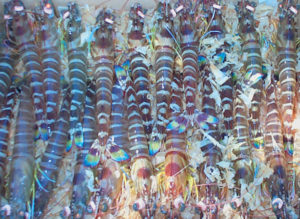
The term ploidy refers to the number of chromosome sets in a cell. In the normal diploid state, each somatic cell has two chromosomes, one from each parent. Male and female gametes (sperm and unfertilized eggs) are haploid, each having only one chromosome.
Normally, the union of a male and female gamete via fertilization restores the diploid condition. However, in many organisms, including shrimp, it is possible to disrupt the process of polar body formation during fertilization by applying thermal, pressure, or chemical shock after sperm and eggs unite. Depending on the timing of the disruption, the resulting cells can having three (triploidy) or four (tetraploidy) sets of chromosomes.
Aquaculture applications
The extent to which triploidy or tetraploidy occurs in natural populations of marine organisms is unknown. However, it is well established that triploidy can be artificially induced in several aquaculture species.
In general, triploid organisms cannot reproduce, and in aquaculture species like fish and mollusks, the induction of triploidy has been very useful in controlling unwanted breeding. Triploidy can also improve production efficiency via improved growth, as in oysters, or single-sex populations, such as in trout.
Shrimp culture and triploidy
The application of triploidy in farmed shrimp is in the early stages of development. Triploidy has been induced in laboratory trials in several species, including kuruma prawns (Penaeus japonicus); Chinese white shrimp (Fenneropenaeus chinensis); and Pacific white shrimp (Litopenaeus vannamei). Although further verification is needed, the results of these trials indicated that the induction of triploidy produced sterile shrimp with growth rates similar to their diploid counterparts.
It has also been demonstrated that the induction of triploidy alters the sex ratio, but to different extents in different species. A female:male ratio of 4:1 has been reported in F. chinensis, whereas trials with P. japonicus resulted in all triploids being female.
Sex ratio alteration
Recent advances in the genetic mapping of P. japonicus have indicated that the female may be the heterogametic sex in this species. This observation – coupled with the apparent lack of male triploids – led to the following hypothesis.
Assuming that females are the heterogametic sex, haploid female gametes can be represented as ZW. An environmental shock applied to the unfertilized haploid egg to prevent the extrusion of the second polar body would result in diploid eggs, ZZ or WW. Subsequent fertilization by homogametic, haploid sperm (Z) would result in triploid embryos, which would either be ZZZ or WWZ.
With two final assumptions that the female chromosome is overdominant (WWZ offspring are phenotypic but sterile females) and that the ZZZ genotype is less or not viable, the scenario fits the observed alterations to sex ratios. Further research is necessary to elucidate the underlying genetic and biochemical processes that occur in triploid shrimp, including the impact on sex ratios.
Triploidy induction
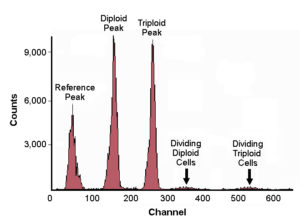
Although the results of experimental trials with triploidy induction are encouraging, commercial-scale production of sterile shrimp via heat or chemical shock to disrupt polar body formation is problematic. The induction of triploidy using these techniques is not 100 percent reliable because the physical disruption of polar body formation requires very precise timing.
The time delay between the spawning of the first and last eggs precludes synchrony of fertilization of any one batch of eggs. Thus, at the time the shock is applied, the emergence of polar bodies will be more advanced in some embryos than others. These differences in timing mean that triploidy induction within and between spawnings can vary 20 to 90 percent.
The ploidy of offspring can be screened using fluorescent activated cell sorting (Fig. 1), as is done for research purposes. However, this is too expensive and time-consuming for commercial application.
Tetraploids
A potential solution to the problem of the variable level of triploidy induction is to produce tetraploid shrimp. In theory, the mating of tetraploids with diploids should produce 100 percent triploids. However, the successful production and growth of tetraploid P. japonicus is yet to be achieved.
(Editor’s Note: This article was originally published in the June 2004 print edition of the Global Aquaculture Advocate.)
Now that you've reached the end of the article ...
… please consider supporting GSA’s mission to advance responsible seafood practices through education, advocacy and third-party assurances. The Advocate aims to document the evolution of responsible seafood practices and share the expansive knowledge of our vast network of contributors.
By becoming a Global Seafood Alliance member, you’re ensuring that all of the pre-competitive work we do through member benefits, resources and events can continue. Individual membership costs just $50 a year.
Not a GSA member? Join us.
Authors
-
Nigel Preston, Ph.D.
CSIRO Marine Research
P.O. Box 120
Cleveland, Queensland 4163 Australia -
Melony Sellars
CSIRO Marine Research
P.O. Box 120
Cleveland, Queensland 4163 Australia -
Frank Coman
CSIRO Marine Research
P.O. Box 120
Cleveland, Queensland 4163 Australia -
Belinda Norris, Ph.D.
CSIRO Livestock Industries
Queensland Bioscience Precinct
St. Lucia, Queensland, Australia -
Russell Lyons, Ph.D.
CSIRO Livestock Industries
Queensland Bioscience Precinct
St. Lucia, Queensland, Australia
Related Posts
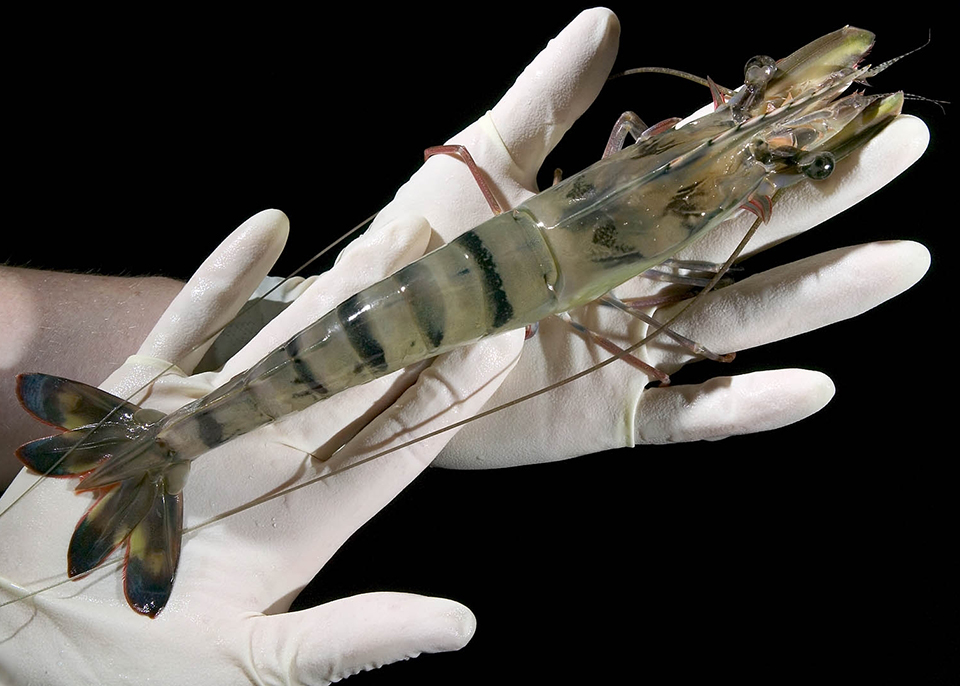
Health & Welfare
Challenges to commercializing shrimp triploidy
Once satisfactory performance is demonstrated in commercial larval rearing and grow-out, automated induction will finalize the triploidy commercialization.
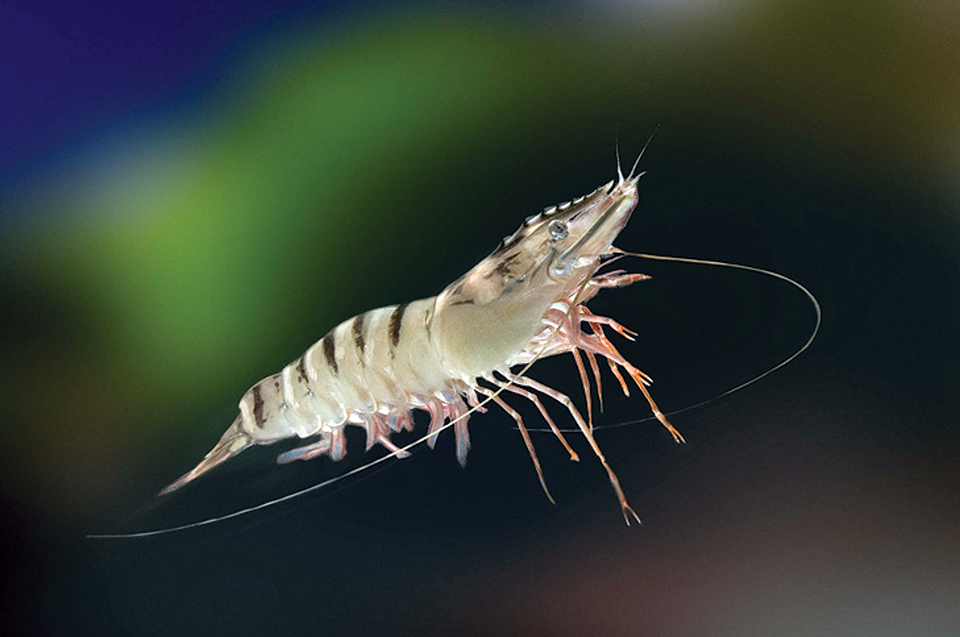
Health & Welfare
Black tiger domestication, selective breeding advance in Australia
Using clear-water tank systems, CSIRO and a collaborating farm have advanced the domestication of black tiger stocks in Australia.

Health & Welfare
CSIRO research evaluates technologies to produce genetically protected, all-female shrimp
In Australia, CSIRO is investigating techniques to produce reproductively sterile, all-female shrimp populations through polyploidy, irradiation, or genetic engineering.
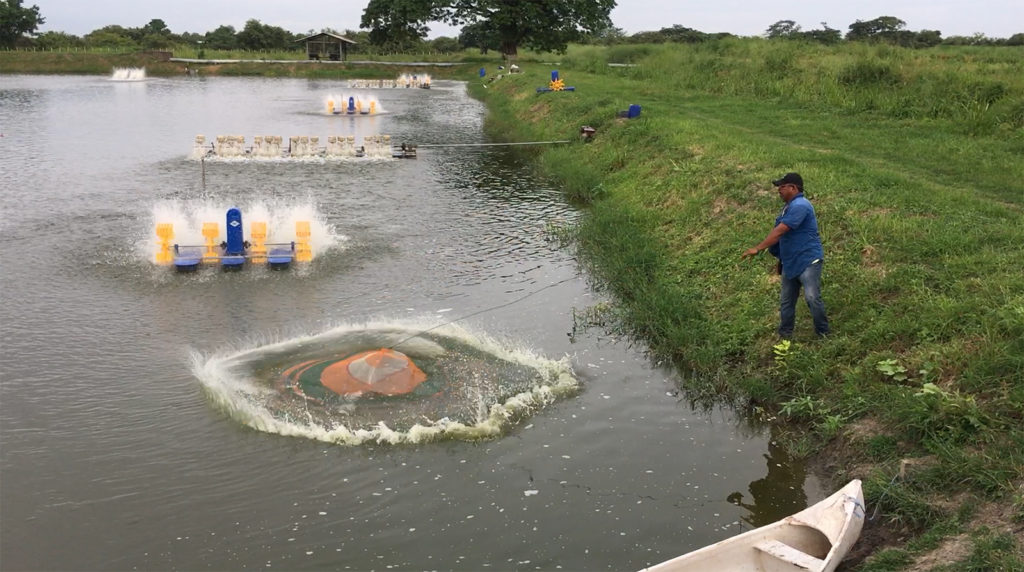
Intelligence
Ongoing production issues in shrimp farming, part 1
More R&D and investment is needed to address various ongoing issues in shrimp farming, including genetic improvement, nutritional requirements and feed ingredients, health management and other issues.


